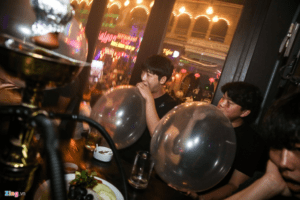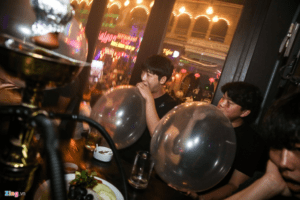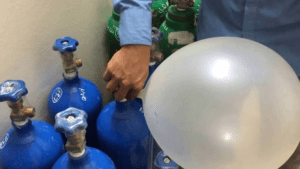Laughing ball: Potential dangers to health?

Laughing ball is a laughing gas, chemical name is Dinitrous monoxide or nitrous oxide, is a chemical compound with the formula N2O. When inflated into a balloon, called a smiley balloon, it is a colorless, odorless gas, also known as laughing gas. When inhaled, the gas will slow down the body's response. This helps the body feel refreshed and euphoric.
N2O gas can be used to help relieve pain, due to its function as a mild sedative. Because of this, N2O is sometimes used before dental procedures to help relax and reduce anxiety. N2O acts as a quick-acting sedative, but in the long-term it loses its effectiveness. Dinitrogen oxide is quite safe. However, like any other drug, it also has side effects. The following article will give you a look at the potential side effects of this gas.
content
- 1. Since when did laughing gas exist?
- 2. What are the side effects if short-term laughing gas is used?
- 3. What are the harmful effects of using a lot of smiley balls?
1. Since when did laughing gas exist?
1.1. What is laughing gas?
It is a colorless, sweet-tasting gas that has been used recreationally since the late 18th century in England. In the early 20th century, N2O gas was approved for medical use as an important sedative and pain reliever, especially in dentistry, obstetrics and sports. Therefore, there must be many people who have used N2O gas but do not know it.
1.2. The effect of laughing gas
In the entertainment world, N2O gas is known as laughing gas or laughing ball. It is legally used in many parts of the world. However, in Vietnam, N2O laughing gas has been banned from use in Hanoi. Laughing gas is commonly used in music festivals, clubs, and bars because it is cheap and creates short euphoria, a feeling of "high" and lightheadedness.

Laughing balls are often used as a stimulant in bars and clubs
N2O can be altered when combined with other drugs. Whether N2O is available depends on the laws of each country. But in general, where the drug is available, it is dispensed from large canisters or tubes, into balloons, which are then used for inhalation.
Because nitrous oxide has legal uses in the food industry (for ice cream or home brewing), it can easily be purchased from online retailers such as food supply companies. . However, according to the Global Drugs Survey, people are buying N2O on the black markets.

N2O gas is pumped into the balloons for inhalation
2. What are the side effects if short-term laughing gas is used?
2.1. What level is safe?
No level of use is considered safe. Using any medication carries risks. It is important to be careful when using the drug. N2O gas is the same, depending on the person, there will be different side effects. These effects may be based on:
- Number of times used.
- User's height, weight and health.
- Used for the first time or used many times.
- Is it used at the same time as other drugs?
Most people use laughing gas with no side effects or complications, however some people may experience side effects while inhaling. N2O is considered to have a relatively low toxicity. However, it can cause dizziness. As a result, you run the risk of harm from falls.
The risks may vary depending on how the drug is taken. Inhaling N2O directly from a pressurized container can damage the lungs. Although rare, a small number of people have died from asphyxiation after becoming unconscious. Most users inhale the drug from small balloons or light bulbs and the dose is low, so the risk of suffocation is virtually nonexistent.
2.2. Side effects
Side effects usually occur when too much gas is inhaled or inhaled too quickly. Common short-term side effects include:
- Sweat a lot.
- Run.
- Nausea.
- Vomit.
- Dizzy.
- Tired.
- Blurred eyes.
- Laugh uncontrollably.
- Movement disorder.
- Sudden death.
Some people may also experience hallucinations (usually vocal hallucinations – sounds that aren't real) after inhaling laughing gas.
If you inhale large amounts of N2O, it can cause:
- Hypotension.
- Faint.
- Heart attack.
- Inhaling N2O can be fatal if there is not enough oxygen to supply it.
2.3. Warning signs and symptoms of an allergic reaction after inhaling laughing gas
- Fever.
- Cold shiver.
- Rash.
- Run.
- Breathing air.
Immediately go to medical facilities if you have the above signs.

If you have any of the above signs of an allergic reaction, seek medical attention immediately
3. What are the harmful effects of using a lot of smiley balls?
Long-term and heavy use of nitrous oxide can lead to vitamin B12 deficiency, which in turn can cause anemia. Vitamin B deficiency can cause tingling in the fingers, toes, and extremities that last for hours or days. More severe cases can lead to numbness and difficulty walking, and the risk is higher in people who already have a vitamin B12 deficiency.
In addition to vitamin B deficiency, prolonged use of N2O may experience other complications such as:
- Lost memory.
- Tinnitus.
- Urinary incontinence.
- Numb hands and feet.
- If used during pregnancy, it can cause birth defects.
- Immunosuppression.
- Depression.
- There is a mentality of substance dependence.
- Psychosis.
N2O - laughing gas is a substance often used by young people for entertainment. Laughing gas is not as harmless as you think. Should be considered and used with caution.
Doctor Nguyen Dao Uyen Trang
See more related articles: